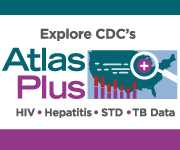Statistics Center
CDC’S National HIV Surveillance System is the primary source for monitoring HIV trends in the United States. CDC funds and assists state and local health departments to collect the information. Health departments report de-identified data to CDC so that information from around the country can be analyzed to determine who is being affected and why.

Surveillance is the ongoing, systematic collection, analysis, interpretation, and dissemination of data regarding a health-related event. HIV surveillance collects, analyzes, and disseminates information about new and existing cases of HIV infection (including AIDS). The ultimate surveillance goal is a nationwide system that combines information on HIV infection, disease progression, and behaviors and characteristics of people at high risk. By meeting this goal, CDC can direct HIV prevention funding to where it is needed the most. AtlasPlus was created to provide an interactive platform for accessing data collected by CDC’s National Center for HIV/AIDS, Viral Hepatitis, STD, and TB Prevention (NCHHSTP). This interactive tool provides CDC an effective way to disseminate data, while allowing users to observe trends and patterns by creating detailed reports, maps, and other graphics. Recent updates to this resource allow users to explore the latest HIV data at the national-, state-, or county-level. Disease rates can be analyzed by demographic variables, transmission categories, year and trends over time. In this new version, users can also create 2 side-by-side maps or charts. New charting capabilities include: line graphs by year; pie charts for sex; bar charts by state and country; bar charts for age, race/ethnicity, and transmission category.
Other Resources
Links
CDC often collaborates with other governmental and non-governmental institutions on gathering and presenting our surveillance information. Our data is also used by these other agencies to help guide their work.
- CDC National Center for Health Statistics
- NCHHSTP State Profiles
- U.S. Census Bureau
- United States Agency for International Development (USAID)
- World Health Organization (WHO)
- Joint United Nations Programme on HIV/AIDS
- Pan American Health Organization (PAHO)
- statehealthfacts.org
Other Documents
- Dear Colleague Letter: Laboratory Reporting of HIV-Related Test Results
- 2012 Consultation on Revision of the HIV Surveillance Case Definition
- Communities in Crisis: Is There a Generalized HIV Epidemic in Impoverished Urban Areas of the United States?
- Dear Colleague Letter: Updated Estimate of the HIV Transmission Rate in the United States
- Page last reviewed: June 28, 2017
- Page last updated: June 28, 2017
- Content source: Division of HIV/AIDS Prevention, National Center for HIV/AIDS, Viral Hepatitis, STD, and TB Prevention, Centers for Disease Control and Prevention


 ShareCompartir
ShareCompartir
